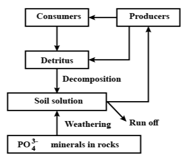Read the given statements and select the correct option.
Statement 1: Decomposition is the physical and chemical breakdown of complex organic matter into simple inorganic substances.
Statement 2: Humification is the process of formation of humus from detritus or organic remains.
Statement 1: Decomposition is the physical and chemical breakdown of complex organic matter into simple inorganic substances.
Statement 2: Humification is the process of formation of humus from detritus or organic remains.
Important Questions on Ecosystem
Select the option that correctly identifies A, B, and C in the given table.
Organism Trophic level Food chain Eagle Grazing Earthworm Primary consumer Frog Grazing
A B C (i) Top carnivore Detritus Secondary consumer (ii) Top carnivore Detritus Primary consumer (iii) Secondary consumer Grazing Secondary consumer (iv) Scavenger Grazing Producer
Read the following statements on ecological succession.
(a) Both hydrarch and xerarch successions lead to hydric and xeric conditions, respectively.
(b) The species that invades a bare area is called a transitional community.
(c) Niche becomes specific and narrower.
(d) Mosses are pioneer communities in hydrarch succession.
How many of the above statements are not correct?
Identify the following statements as true (T) or false (F) for climax community and choose the option accordingly.
A. It is last community in biotic succession.
B. It is less stable than transitional communities.
C. It is in near equilibrium with the environment of that area.
D. It has a simple food chain and food webs.
Fragmentation, leaching, and catabolism are some important steps of decomposition. Study the following statements [(i), (ii), and (iii)] regarding these and select the correct option.
(i) Detritivores (e.g., earthworm) breakdown detritus into smaller particles.
(ii) Water-soluble inorganic nutrients go down into the soil horizon and get precipitated as unavailable salts.
(iii) Decomposers (e.g., bacteria and fungi) secrete digestive enzymes and degrade detritus into simpler inorganic substances.
Leaching Fragmentation Catabolism (i) (ii) (iii) (iii) (ii) (i) (ii) (i) (iii) (ii) (iii) (i)
Match I with II and choose the correct option from the given codes.
I II (a) Population (i) Part of the earth consisting of all the ecosystems of the world (b) Community (ii) Assemblage of all the individuals belonging to different species occurring in an area (c) Ecosystem (iii) Group of similar individuals belonging to the same species, found in an area (d) Ecosphere (iv) Interaction between the living organism and their physical environment (v) Classification of organism based on the type of environment
Given below is a phosphorus cycle. Select the incorrect statements from the following.

(i) It represents phosphorus cycling in an aquatic ecosystem.
(ii) It represents phosphorus cycling in a terrestrial ecosystem.
(iii) The natural reservoir of phosphorus is forest rocks.
(iv) There is a respiratory release of phosphorus into the atmosphere.
(v) Gaseous exchange of phosphorus between organisms and the environment does not occur.
